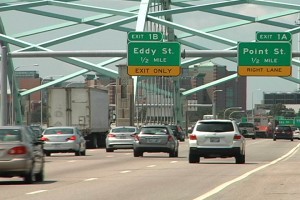Editor’s Note: The Iway Bridge has gotten a lot of media attention the past month as the Department of Transportation acknowledges a design flaw in the guard rails lining the span of the bridge. This week, the Hummel Report is the only media outlet to sit down for an interview with the head man at DOT – and he has some candid words about accountability.
 It is the signature piece of a $600 million relocation of Route 195. And it’s now eight years old. But for more than a year, four sets of Jersey barriers have greeted motorists traveling each way on the Iway Bridge. That’s because the guardrails put in after the bridge was floated into place in 2006 were installed improperly.
It is the signature piece of a $600 million relocation of Route 195. And it’s now eight years old. But for more than a year, four sets of Jersey barriers have greeted motorists traveling each way on the Iway Bridge. That’s because the guardrails put in after the bridge was floated into place in 2006 were installed improperly.
“It’s safe to operate now. It doesn’t affect traffic. But we didn’t get what we paid for,” says Michael Lewis, director of the Rhode Island Department of Transportation. “We didn’t get the connection of the rail to the deck of the bridge as was required by the contract.”
Lewis said a routine inspection in spring 2013 turned up a damaged rail and the surrounding concrete on the right side of the eastbound span. “Clearly something hit the rail. We had no indication of an accident; it must have deflected the car back into the traffic and they moved on. But it did do damage to the base of the rail. That was unusual because the energy from the crash should be absorbed by the concrete.”
Additional testing turned up rail deficiencies along other parts of the bridge, so as a precaution, the DOT had the contractor, Cardi Corporation of Warwick, install the Jersey barriers. Then they hired an engineering firm to find out what the problem is.
Lewis said the rail itself is not the issue. “The bridge rail that was picked for this project was approved rail going back to the 1990s. No problem with the design or with the rail that was picked for the bridge. The problem was with how it was installed.’’
Jim Hummel: Does that go back to the contractor?
Michael Lewis: Ultimately it does. Based on a preliminary assessment, one thing is sure: It wasn’t built according to plan. I don’t think anybody can debate that. So the contractor has responsibility.
JH: And financial responsibility as well?
ML: Yeah, under the contract.
JH: No question about that?
ML: Not in our mind and I think if you were to ask the Cardis they would agree. I think if you were to ask the Cardis they are equally appalled that this could have happened. This was an in-the-field decision or lack of decision that was made.
So we contacted Cardi, which has been operating in Rhode Island for four generations. Stephen Cardi II told us that the company has been waiting for the DOT to conclude its study and forward it to the company so they can do their own analysis.
“We have to confirm all of this,” Cardi said. “When you start throwing responsibility around, you have to be cautious. We do quality work and are responsible corporate citizens. If there’s something that needs to be fixed we will fix it. We don’t run away from a problem, but we need information from the DOT to confirm it.”
ML: This happens not infrequently in heavy civil construction. Where you get a conflict in the field that’s different than what’s on the design drawings, under the contract terms it could be considered a different site condition.
JH: Don’t you have inspectors, though, that are periodically inspecting? Is that part of the review?
ML: That’s part of the review. What did the department do or not do that should have been done at the time? And that’s important because it’s a lesson learned going forward. But ultimately it’s the contractor’s responsibility and that’s built right into the contract. In my mind, this should have been picked up by the inspection. For some reason, it either was and it was let go, or it wasn’t. Both of those are a problem.
Lewis says the problem, which will involve some type of retrofit, will not be fixed until well into next year, but reiterated the bridge is safe with the Jersey barriers in place. And it’s unclear right now how much the solution will cost.
So will taxpayers be on the hook?
“We don’t think so. Right now, no,” Lewis said. “I could have said, ‘You know what? Let’s go and do this repair and we’ll pay for it and then we’ll fight about it later.’ I don’t want to do that. There’s no reason to do that. I want to have the facts before us. I want to sit down with the Cardis and say, ‘Per the contract, we need to take corrective action. What’s your response?'”
The Hummel Report is a 501 3C non-profit organization that relies, in part, on your donations. If you have a story idea or want make a donation go to www.hummelreport.org, where you can also see the video version of this story at hummelreport.org/Stories/8.14.2014.iway.html. You can mail Jim directly at jim@hummelreport.org.